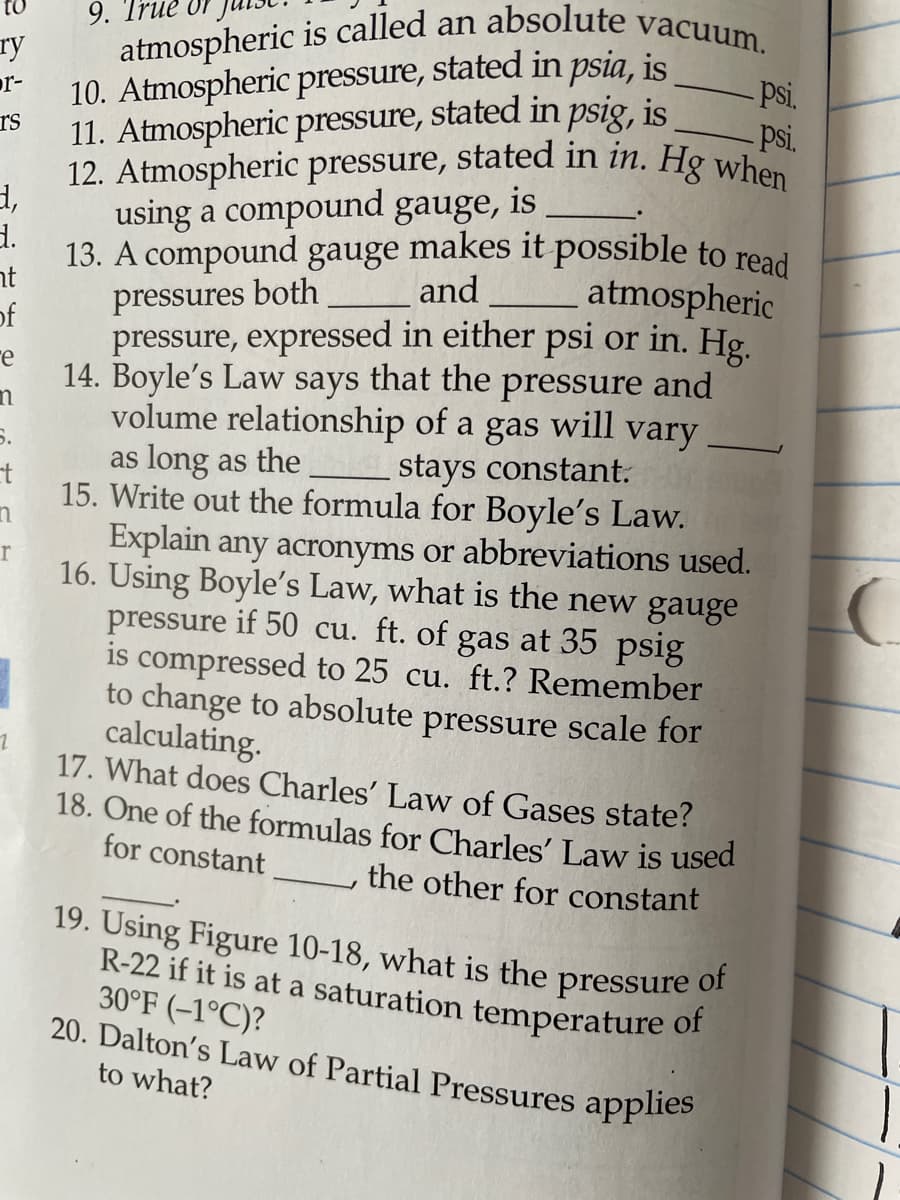10. Atmospheric pressure, Stau 11. Atmospheric pressure, stated in psig, is 12. Atmospheric pressure, stated in in. Hg w using a compound gauge, is . 13. A compound gauge makes it possible to r pressures both pressure, expressed in either psi or in. Hg 14. Boyle's Law says that the pressure and volume relationship of a gas will vary as long as the 15. Write out the formula for Boyle's Law. Explain any acronyms or abbreviations used 16. Using Boyle's Law, what is the new gauge pressure if 50 cu. ft. of gas at 35 psig is compressed to 25 cu. ft.? Remember to change to absolute pressure scale for calculating. 17. What does Charles' Law of Gases state? 18. One of the formulas for Charles' Law is used psil, is and atmosphe stays constant. for constant the other for constant 19. Using Figure 10-18, what is the pressure of R-22 if it is at a saturation temperature ol 30°F (-1°C)? 20. Dalton's Law of Partial Pressures applies to what?
10. Atmospheric pressure, Stau 11. Atmospheric pressure, stated in psig, is 12. Atmospheric pressure, stated in in. Hg w using a compound gauge, is . 13. A compound gauge makes it possible to r pressures both pressure, expressed in either psi or in. Hg 14. Boyle's Law says that the pressure and volume relationship of a gas will vary as long as the 15. Write out the formula for Boyle's Law. Explain any acronyms or abbreviations used 16. Using Boyle's Law, what is the new gauge pressure if 50 cu. ft. of gas at 35 psig is compressed to 25 cu. ft.? Remember to change to absolute pressure scale for calculating. 17. What does Charles' Law of Gases state? 18. One of the formulas for Charles' Law is used psil, is and atmosphe stays constant. for constant the other for constant 19. Using Figure 10-18, what is the pressure of R-22 if it is at a saturation temperature ol 30°F (-1°C)? 20. Dalton's Law of Partial Pressures applies to what?
Refrigeration and Air Conditioning Technology (MindTap Course List)
8th Edition
ISBN:9781305578296
Author:John Tomczyk, Eugene Silberstein, Bill Whitman, Bill Johnson
Publisher:John Tomczyk, Eugene Silberstein, Bill Whitman, Bill Johnson
Chapter11: Calibrating Instruments
Section: Chapter Questions
Problem 13RQ
Related questions
Question
100%
I need all the answers From number 10 to number 20 I need all the answers

Transcribed Image Text:atmospheric is called an absolute vacuum.
ту
or-
10. Atmospheric pressure, stated in psia, is
12. Atmospheric pressure, stated in in. Hg when
13. A compound gauge makes it possible to read
9.
-psi.
-psi.
11. Atmospheric pressure, stated in psig, is
rs
d,
d.
nt
of
using a compound gauge, is
and
atmospheric
pressures both
pressure, expressed in either psi or in. Hg.
14. Boyle's Law says that the pressure and
volume relationship of
as long as the
15. Write out the formula for Boyle's Law.
Explain any acronyms or abbreviations used.
16. Using Boyle's Law, what is the new gauge
pressure if 50 cu. ft. of gas at 35 psig
is
re
a gas
will
vary
5.
stays constant.
compressed to 25 cu. ft.? Remember
to change to absolute pressure scale for
calculating.
17. What does Charles' Law of Gases state?
18. One of the formulas for Charles' Law is used
for constant
the other for constant
19. Using Figure 10-18, what is the pressure o"
R-22 if it is at a saturation temperature of
30°F (-1°C)?
20. Dalton's Law of Partial Pressures applies
to what?
Expert Solution
This question has been solved!
Explore an expertly crafted, step-by-step solution for a thorough understanding of key concepts.
This is a popular solution!
Trending now
This is a popular solution!
Step by step
Solved in 2 steps with 1 images

Knowledge Booster
Learn more about
Need a deep-dive on the concept behind this application? Look no further. Learn more about this topic, mechanical-engineering and related others by exploring similar questions and additional content below.Recommended textbooks for you

Refrigeration and Air Conditioning Technology (Mi…
Mechanical Engineering
ISBN:
9781305578296
Author:
John Tomczyk, Eugene Silberstein, Bill Whitman, Bill Johnson
Publisher:
Cengage Learning

Refrigeration and Air Conditioning Technology (Mi…
Mechanical Engineering
ISBN:
9781305578296
Author:
John Tomczyk, Eugene Silberstein, Bill Whitman, Bill Johnson
Publisher:
Cengage Learning